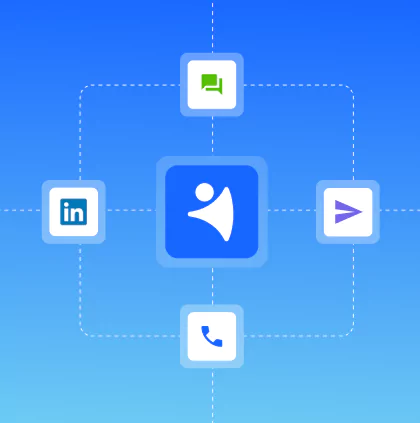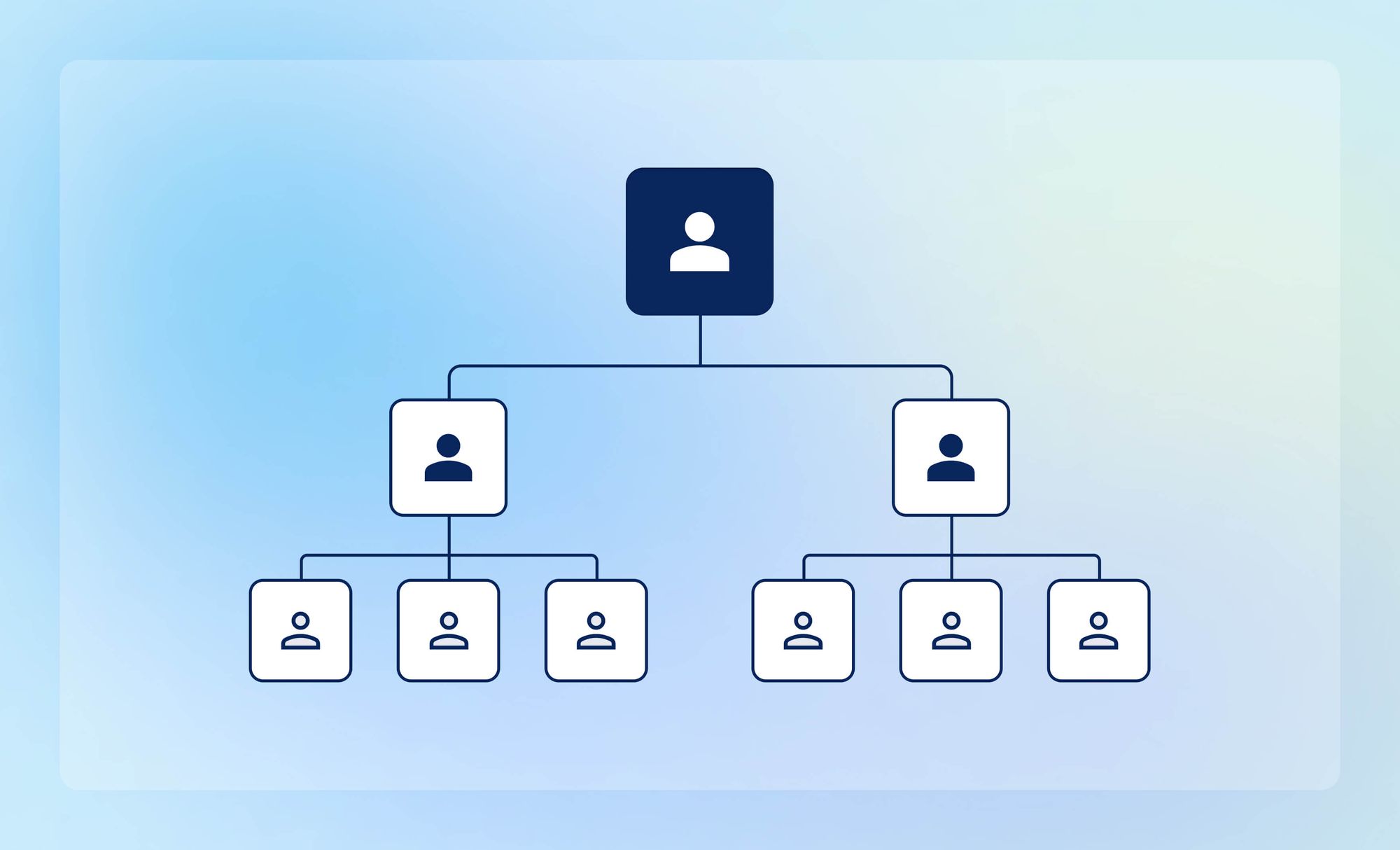Forget about wasted meetings! Learn how to quickly connect with key B2B decision makers.
Picture this. You’ve just had a perfect discovery call, a company rep loves your product, and it seems like they’re ready to buy. But then you hear, ‘Well, I should consult my boss first…’
Now, you have to schedule another meeting and start all over again ?.
Well, here is how to identify and reach the right B2B decision makers — the ones with the final say on the deal — right from the start.
Who are B2B decision makers?
B2B decision-makers are individuals within a company who have the authority to approve or reject a purchase. They control budgets, approve projects, and have the final say on whether your product or service aligns with their company’s goals, budget, and operational needs.
C-suite executives (CEOs, CFOs, CTOs) are often core decision-makers within a company, but that’s not always the case. In many companies, B2B decision making might be delegated to:
- Heads of sales, marketing, IT, or finance departments who oversee specific budgets and tools for their teams.
- Procurement officers who research, compare, and choose vendors.
- Operations managers who are in charge of efficiency, ensuring tools and services align with workflows.
- Project groups. These are often teams assigned to research, evaluate, and present solutions before final approval (include multiple decision makers of different levels).
❗ If you don’t reach those decision makers directly — or at least influence those who do — you risk wasting time and losing deals.
What are the stages of a B2B decision making process?
In many ways, B2B decision making mirrors the common customer decision making process but comes with more complexity and stakeholders involved.
- Recognizing the problem and the need to solve it. Now that is definitely the perfect stage to engage with the company. They haven’t started their research yet, and you have a chance to get ahead of the competitors and highlight the benefits of your product.
- Gathering the data on possible solutions. During this stage, the company goes through user testimonials, detailed case studies, or feature comparisons to narrow down their choices. It’s still easy to persuade your prospect during this stage with a good value selling where you compare your service or product to competitors.
- Engaging with the sellers. During this stage, it gets more difficult to persuade the decision maker that you’re the best on the market as they’ve already requested demos, case studies, and pricing details from other solution providers.
- Internal evaluation. At this stage, B2B decision-makers have narrowed down their options and are now discussing them internally, bringing in teams from finance, IT, and compliance.
- Final decision making. Here, the company has already tested all the options, and decision makers approve the budget for the solution that best fits their needs.
How to reach B2B decision makers fast: 3 easy tips
Here are a few things you can do to quickly connect with and influence key B2B decision makers within a company.
#1: Use your ideal buyer persona profile
Find out who can benefit from your solution within the company.
Let’s say your business specializes in sales engagement tools for sales teams in mid-sized companies. In this case, your ideal buyer persona is the Head of Sales or Sales Director, who oversees sales strategy and technology adoption for their team.
Also, there is no need to cast a wide net on the entire sales team — just focus on the key decision-makers who have the authority to say ‘yes.’ In this case, that would be the Head of Sales department.
#2: Learn the hierarchy and positions
Research how the company is structured. Large enterprises may have multiple layers of decision-making, while startups often rely on a single CEO or founder.
Eventually, there are 3 common types of decision-making scenarios within the company:
- Single decision maker. Common in small businesses where the CEO or owner has the final say.
- Multiple B2B decision makers. A head of a particular department might consult their team before deciding on your product or service (especially if the team members would be the core users of the product).
- Committee-based decisions. Some companies require a cross-functional team (IT, finance, compliance) to approve purchases.
Sometimes, you’ll have to deal with the project group (those might include researchers, analysts, and department leads), often a part of the decision-making unit (DMU) or, we’d rather call it, the ‘research group,’ —- people who’re responsible for analyzing the market and the proposals they get before they bring the recommendations to the board.
Sure, the project group aren’t the core decision makers, but they represent the interest of a particular team or department and are the ones who can persuade the right people to buy from you ?. So, engage with them wisely.
#3: Leverage online resources
You can find those people responsible for making top decisions in the company on the company’s website, news sources, LinkedIn, and social media. A name and an email address would suffice — if you know where to look for publicly available data. But what to do if the contact data is nowhere to be found?
- Check out your contact’s posts and comments on LinkedIn and social media to start a conversation. Engage with their content by leaving thoughtful comments or sharing relevant insights. A well-placed comment can grab their attention and open the door to a meaningful dialogue.
- Check their email signature. If you find any content they’ve publicly shared (blog posts, guest articles, or white papers), sometimes their email or contact details will be included in the signature.
- Use data intelligence platforms and data enrichment tools to identify key contacts, track job position changes, and access verified email addresses.
- Attend professional network events whether online or in person. You never know who you’re gonna meet at a webinar or industry conference and whose valuable contact information you’re going to get. What if you meet someone from the team who can introduce you to the decision maker themselves?
? Not only does a solution like NetHunt CRM help you keep all your contacts in one organized database, but it also natively integrates with data enrichment tools like Apollo and Hunter to help you access up-to-date prospect details and reach the right decision-makers faster.
What to do once you’ve found your perfect contact?
Congrats! Now all you’ve got to do is engage with your ideal contact thoughtfully.
Personalize your approach
First, which is the preferred channel of communication? You don’t want to send another email to their already overloaded inbox, especially if your B2B decision makers prefer communicating via social media.
Regardless of their preferred communication channel, please don’t send generic messages —- people hate them ?. Start with something specific about them or their company that caught your attention. Also, be empathetic towards your prospect’s struggles — your message should invite the conversation without you being sales-pushy.
Here are a few examples of compassionate, ‘let’s-collaborate’ messages to send to your prospect:
Example #1: Talk about the recent post. ‘"Hi [Name], I saw your recent post about how exhausting it is to juggle customer engagement across multiple channels. It’s such a big task! I’d love to hear more about how you’re approaching it — maybe we can exchange some ideas.”
Example #2: Congratulate them on the new product or service launch. ‘Hey [Name], congrats on the new product launch! That must be both exciting and challenging. We’ve worked with businesses in your industry and seen the common hurdles that come up. I’d love to hear how things are going for you!’
Example #3: Acknowledge their industry challenges. "Hi [Name], I know that [X] has been a big topic lately, and I imagine it’s something your team is navigating too. I’d love to hear your perspective on how you’re tackling it!"
Example #4: Show appreciation for their insights. "Hey [Name], I really enjoyed your recent talk/article on [X]. Your take on [specific point] was especially interesting! I’d love to hear more about how you’re applying it in your work."
Example #5: Connect over shared interests. "Hi [Name], I noticed we both share an interest in [X]. It’s always great to connect with people who are passionate about such things! Would love to hear your thoughts on [X]!"
Don’t push a sale too soon
Forget about hard selling and approach them with a solution.
B2B decision makers are busy, and they won’t engage with you if they don’t see immediate value.
? Be useful. You can:
- Offer a free helpful resource that tackles the company’s problem. "Hi [Name], I know [X] is a big topic right now. We recently put together a quick guide on how teams are handling it — let me know if you’d like a copy!"
- Introduce a fresh idea. "Hi [Name], I’ve been chatting with other [role/industry] professionals about [X], and some of the solutions they’re testing are really interesting. Would love to hear what’s working for you!"
- Highlight a recent relevant success story. "Hey [Name], I recently spoke with a [similar company/industry peer] that found a creative way to tackle [X]. Thought you might find it interesting — happy to share!"
- Share a surprising trend or industry statistics. "Hey [Name], I just came across a stat that really caught my attention — [insert relevant stat about industry challenge]. Given your experience, I’d love to hear if this aligns with what you’re seeing in the field!"
Ask for a low-pressure first meeting
After you’ve provided some value, it’s time to ask for a quick, no-pressure meeting or demo.
Keep it light and low-stakes to remove the pressure of a hard sell and show you respect their time.
? You might finish your message as follows:
- Knowledge exchange. “How about a 10-15 minute chat to exchange some insights? I’ve seen a few approaches that might be helpful for your team, and I’d love to hear what’s working on your end.”
- Free consultation. “If you’ve got 15 minutes, I’d be happy to chat about a few strategies I’ve seen working for others in your industry. No pressure, just sharing what’s been effective!”
- Seek advice. “I’m always looking to learn more about [X]. Would you be open to a quick 15-minute conversation to share your thoughts or any advice on this?"
- Show expertise. “I’ve noticed a few areas in your current approach to [X] that might benefit from a slight adjustment. I’d love to share some quick suggestions if you’re open to it — just a brief, no-pressure chat.”
- A little bit more salesy approach. “How about a 15-minute demo to show you how we could help improve your team’s efficiency? No obligation, just a conversation.”
Follow-up but don’t spam
If no one responds to your first email or call, don’t worry! It happens. Just be sure to follow up with a friendly reminder. You can also add something new to the conversation, like an interesting article or a new insight you’ve discovered.
Here are a few examples of low-pressure follow-ups that show persistence but aren’t pushy:
Example #1: “Hi [Name], I thought you might find this recent statistics on [X] helpful. It offers some great insights on [Y]. Hope it helps!”
Example #2: “Hi [Name], no pressure — just found a neat case study on [X] that might save your team time. Want me to send it over?”
Example #3: “Hey [Name], hope all is well! I came across a new tool for [X] that could help improve things. If you’re curious, I’d love to share it!”
Example #4: “Hi [Name], just following up in case you missed my last message. I found a case study that might be helpful for tackling [X]. Let me know if you'd like to check it out!"
Example #5: “Hi [Name], I found something today that could be a game-changer for your team. Would love to hear your thoughts on it if you have a moment!"
Final thoughts
Keep in mind that decision-making power doesn’t always sit with the C-suite. Often, department heads, procurement officers, or even project teams have a final say in the buying process. Understanding the company’s structure and engaging with the right B2B decision makers can save you time and shorten your sales cycle.
Anyway, the main rule is to be genuine in your outreach. The more authentic and value-driven your approach is, the easier it will be to build lasting relationships.
You’ve got it!
FAQ
Who are B2B decision makers?
B2B decision-makers are the people who have the authority to approve purchases or influence buying decisions within a company. They can be C-suite executives, department heads, or key stakeholders who control budgets and strategy.
How to find B2B decision makers?
To find B2B decision makers, check out the company's website, company’s presence on social media and LinkedIn, and industry directories (if there are such online). You can also attend industry events and engage in relevant online communities or even use data intelligence tools to automate your search.
What are the types of B2B decision makers?
B2B decision makers come in three main types. In small businesses, a single decision maker (often the CEO or owner) has the final say. In larger companies, multiple decision makers may be involved, where a department head consults with their team, especially if the team will be the primary users. Finally, some companies require committee-based decisions, where a cross-functional group, including departments like IT, finance, and compliance, must agree before making a purchase.




















 product experts — let's find the best setup for your team
product experts — let's find the best setup for your team